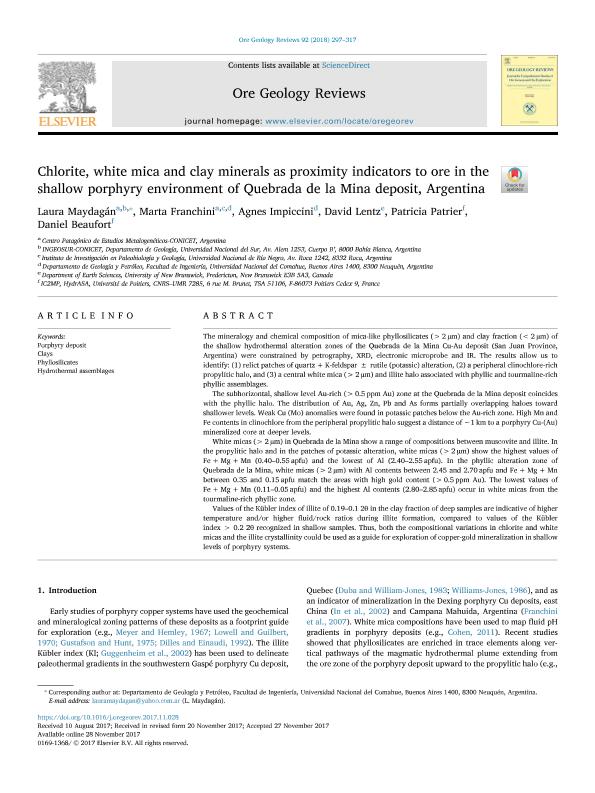Mostrar el registro sencillo del ítem
dc.contributor.author
Maydagán, Laura

dc.contributor.author
Franchini, Marta Beatriz

dc.contributor.author
Impiccini, Agnes

dc.contributor.author
Lentz, David
dc.contributor.author
Patrier, Patricia
dc.contributor.author
Beaufort, Daniel
dc.date.available
2018-10-29T20:26:25Z
dc.date.issued
2018-01
dc.identifier.citation
Maydagán, Laura; Franchini, Marta Beatriz; Impiccini, Agnes; Lentz, David; Patrier, Patricia; et al.; Chlorite, white mica and clay minerals as proximity indicators to ore in the shallow porphyry environment of Quebrada de la Mina deposit, Argentina; Elsevier Science; Ore Geology Reviews; 92; 1-2018; 297-317
dc.identifier.issn
0169-1368
dc.identifier.uri
http://hdl.handle.net/11336/63252
dc.description.abstract
The mineralogy and chemical composition of mica-like phyllosilicates (>2 µm) and clay fraction (<2 µm) of the shallow hydrothermal alteration zones of the Quebrada de la Mina Cu-Au deposit (San Juan Province, Argentina) were constrained by petrography, XRD, electronic microprobe and IR. The results allow us to identify: (1) relict patches of quartz + K-feldspar ± rutile (potassic) alteration, (2) a peripheral clinochlore-rich propylitic halo, and (3) a central white mica (>2 µm) and illite halo associated with phyllic and tourmaline-rich phyllic assemblages. The subhorizontal, shallow level Au-rich (>0.5 ppm Au) zone at the Quebrada de la Mina deposit coincides with the phyllic halo. The distribution of Au, Ag, Zn, Pb and As forms partially overlapping haloes toward shallower levels. Weak Cu (Mo) anomalies were found in potassic patches below the Au-rich zone. High Mn and Fe contents in clinochlore from the peripheral propylitic halo suggest a distance of ∼1 km to a porphyry Cu-(Au) mineralized core at deeper levels. White micas (>2 µm) in Quebrada de la Mina show a range of compositions between muscovite and illite. In the propylitic halo and in the patches of potassic alteration, white micas (>2 µm) show the highest values of Fe + Mg + Mn (0.40–0.55 apfu) and the lowest of Al (2.40–2.55 apfu). In the phyllic alteration zone of Quebrada de la Mina, white micas (>2 µm) with Al contents between 2.45 and 2.70 apfu and Fe + Mg + Mn between 0.35 and 0.15 apfu match the areas with high gold content (>0.5 ppm Au). The lowest values of Fe + Mg + Mn (0.11–0.05 apfu) and the highest Al contents (2.80–2.85 apfu) occur in white micas from the tourmaline-rich phyllic zone. Values of the Kübler index of illite of 0.19–0.1 2θ in the clay fraction of deep samples are indicative of higher temperature and/or higher fluid/rock ratios during illite formation, compared to values of the Kübler index > 0.2 2θ recognized in shallow samples. Thus, both the compositional variations in chlorite and white micas and the illite crystallinity could be used as a guide for exploration of copper-gold mineralization in shallow levels of porphyry systems.
dc.format
application/pdf
dc.language.iso
eng
dc.publisher
Elsevier Science

dc.rights
info:eu-repo/semantics/openAccess
dc.rights.uri
https://creativecommons.org/licenses/by-nc-nd/2.5/ar/
dc.subject
Clays
dc.subject
Hydrothermal Assemblages
dc.subject
Phyllosilicates
dc.subject
Porphyry Deposit
dc.subject.classification
Geología

dc.subject.classification
Ciencias de la Tierra y relacionadas con el Medio Ambiente

dc.subject.classification
CIENCIAS NATURALES Y EXACTAS

dc.title
Chlorite, white mica and clay minerals as proximity indicators to ore in the shallow porphyry environment of Quebrada de la Mina deposit, Argentina
dc.type
info:eu-repo/semantics/article
dc.type
info:ar-repo/semantics/artículo
dc.type
info:eu-repo/semantics/publishedVersion
dc.date.updated
2018-10-22T19:01:12Z
dc.journal.volume
92
dc.journal.pagination
297-317
dc.journal.pais
Países Bajos

dc.journal.ciudad
Amsterdam
dc.description.fil
Fil: Maydagán, Laura. Consejo Nacional de Investigaciones Científicas y Técnicas. Centro Científico Tecnológico Conicet - Bahía Blanca. Instituto Geológico del Sur. Universidad Nacional del Sur. Departamento de Geología. Instituto Geológico del Sur; Argentina. Universidad Nacional del Comahue. Facultad de Ingeniería. Departamento de Geología y Petróleo; Argentina
dc.description.fil
Fil: Franchini, Marta Beatriz. Consejo Nacional de Investigaciones Científicas y Técnicas. Centro Científico Tecnológico Conicet - Patagonia Norte; Argentina. Universidad Nacional de Río Negro. Sede Alto Valle. Instituto de Investigaciones en Paleobiología y Geología; Argentina. Universidad Nacional del Comahue. Facultad de Ingeniería. Departamento de Geología y Petróleo; Argentina
dc.description.fil
Fil: Impiccini, Agnes. Universidad Nacional del Comahue. Facultad de Ingeniería. Departamento de Geología y Petróleo; Argentina
dc.description.fil
Fil: Lentz, David. University of New Brunswick; Canadá
dc.description.fil
Fil: Patrier, Patricia. Centre National de la Recherche Scientifique; Francia. Université de Poitiers; Francia
dc.description.fil
Fil: Beaufort, Daniel. Centre National de la Recherche Scientifique; Francia. Université de Poitiers; Francia
dc.journal.title
Ore Geology Reviews

dc.relation.alternativeid
info:eu-repo/semantics/altIdentifier/doi/http://dx.doi.org/10.1016/j.oregeorev.2017.11.028
dc.relation.alternativeid
info:eu-repo/semantics/altIdentifier/url/https://www.sciencedirect.com/science/article/pii/S0169136817306108
Archivos asociados
